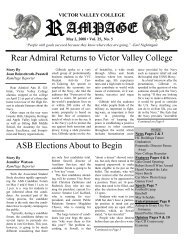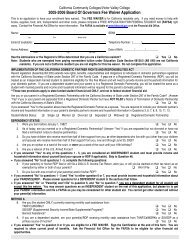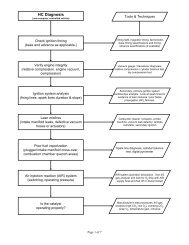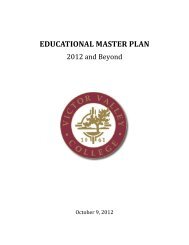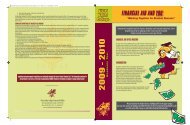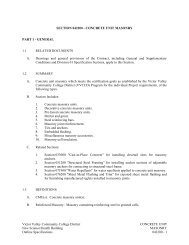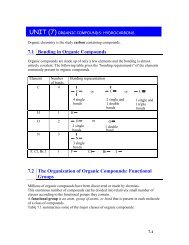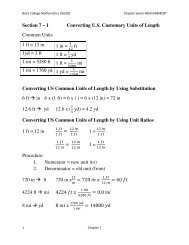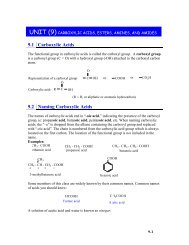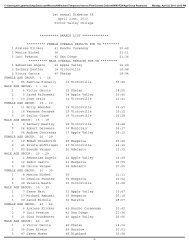Download - Victor Valley College
Download - Victor Valley College
Download - Victor Valley College
Create successful ePaper yourself
Turn your PDF publications into a flip-book with our unique Google optimized e-Paper software.
PROGRAMS / COURSE DESCRIPTION<br />
BIOLOGICAL SCIENCE<br />
BIOL 214 VERTEBRATE ZOOLOGY<br />
Units: 4.0 - 48-54 hours lecture and 48-54 hours<br />
laboratory. CSU. (Prerequisite: BIOL 100, or H100 or<br />
201 with a grade of “C” or better). May be taken two<br />
times.<br />
This rigorous course provides students with a<br />
comprehensive introduction to the vertebrates by<br />
examining comparative vertebrate morphology,<br />
development, and behavior from an evolutionary<br />
perspective. The lectures present an overview of the<br />
major vertebrate groups, including fish, amphibians,<br />
reptiles, birds, and mammals. Critical analyses of<br />
current controversies in the study of vertebrate evolution<br />
are also discussed, as well as human impacts to<br />
vertebrate species and their environments. Lab work<br />
includes examining living and preserved specimens<br />
(including dissections), providing the opportunity to<br />
examine the structure of organ systems and adaptations<br />
to the environment. Several local field trips are taken to<br />
study vertebrates in the wild and in captivity. This<br />
course, which stresses critical thinking and problemsolving<br />
skills, is designed for pre-professional and<br />
biology majors, but it is open to all students.<br />
BIOL 215 HUMAN GROSS ANATOMY<br />
Units: 4.0 - 48-54 hours lecture and 48-54 hours<br />
laboratory. CSU. (No prerequisite)<br />
An advanced anatomy class that utilizes a regional<br />
approach to the study of the thorax, abdomen, pelvis,<br />
back, extremities, head and neck. Lecture will include<br />
medical/clinical applications and case studies on these<br />
regions. Laboratory includes hands on group dissection<br />
on a whole cadaver; as well as work on a high-level<br />
anatomy software program.<br />
BIOL 221 GENERAL MICROBIOLOGY<br />
Units: 5.0 - 48-54 hours lecture and 96-108 hours<br />
laboratory. CSU, UC. (Prerequisites: BIOL 100 or BIOL<br />
H100, 107 or 201; CHEM 100 or CHEM H100, or<br />
CHEM 201; all completed with a grade of “C” or better.)<br />
Introduction to bacteria, viruses, and parasitic forms of<br />
protozoa, helminths, and fungi. Examination of<br />
morphological, physiological, and epidemiological<br />
characteristics of these organisms and of the immune<br />
response produced by their hosts.<br />
topics to be covered are biochemical aspects of cell<br />
homeostasis. The laboratory will include demonstrations<br />
and experiments to support basic physiological<br />
concepts. Included are experiments selected<br />
specifically for instruction in the interpretation of<br />
physiological tests and diagnostic testing procedures.<br />
BIOL 233 PATHOPHYSIOLOGY<br />
Units: 3.0 - 48-54 hours lecture. CSU (Prerequisite:<br />
BIOL 231 with a grade of ‘C’ or better.)<br />
This course is designed to promote understanding and<br />
application of fundamental disease processes in clinical<br />
settings. General concepts of disease, including<br />
etiology, pathogenesis, morphology and clinical<br />
significance are discussed. General pathophysiology<br />
concepts include cell injury, necrosis, inflammation,<br />
wound healing and neoplasia. These concepts are<br />
applied in a systems-oriented approach to disease<br />
processes affecting musculoskeletal, cardiopulmonary,<br />
renal, nervous, gastrointestinal, immune, hematological<br />
and endocrine systems.<br />
BIOL 250A ECOSYSTEM FIELD BIOLOGY<br />
Units: 3.0 - 16-18 hours lecture and 96-108 hours<br />
laboratory. CSU (Prerequisite: BIOL 100, BIOL H100 or<br />
equivalent. Grade Option)<br />
This course lets students experience various<br />
ecosystems from a fieldwork and research perspective.<br />
Students will learn research techniques hands-on from<br />
basic specimen collecting, species identification, and<br />
data gathering in the field to data analysis and scientific<br />
writing and will apply these in biodiversity surveys of<br />
terrestrial or aquatic habitats or both. An emphasis will<br />
be placed on amphibians and reptiles, or plant life, or<br />
birds, or mammals, or a combination of these<br />
(depending on the specialty of the instructor) and<br />
adaptations to life in tropical or other ecosystems. Pretrip<br />
lectures will include information about habitats and<br />
organisms of the destination country, as well as<br />
previews of activities and adventures you will<br />
experience on the field trip. Trips vary in length from 9<br />
days to 2.5 weeks. This course is intended for biology<br />
majors but is open to all students. Non-majors who<br />
wish to participate with less rigorous course<br />
requirements may wish to enroll in BIOL 98,<br />
Comparative Natural History Studies, which is offered<br />
concurrently.<br />
BIOL 231 HUMAN PHYSIOLOGY<br />
Units: 5.0 - 48-54 hours lecture and 96-108 hours<br />
laboratory. CSU, UC. (Prerequisites: BIOL 100 or BIOL<br />
H100, BIOL 107, BIOL 201, or BIOL 211, CHEM 100 or<br />
CHEM H100, or CHEM 201; all completed with a grade<br />
of “C” or better.)<br />
An introduction to general physiology with emphasis on<br />
the functioning of the human body. Included in the<br />
BIOL H295 BIOLOGICAL SCIENCE RESEARCH<br />
Units: 3.0 - 48-54 hours lecture. CSU, UC<br />
(Prerequisites: Biol 100 or H100, Biol 201, Biol 202 or<br />
Biol 231 with a grade of ‘C’ or better). This course may<br />
be taken four times.<br />
An approach to biological research integrating scientific<br />
writing and scholarly presentation methods. Formulating<br />
experimental approaches to current questions in<br />
138 2012-2013 <strong>Victor</strong> <strong>Valley</strong> <strong>College</strong> Catalog



